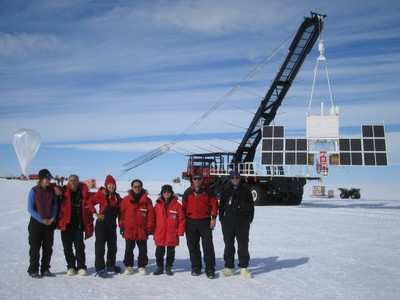Still Flying At Over 111,000 Feet, 12 Days After Launch
 NASA
and the National Science Foundation have successfully launched and
demonstrated a newly-designed super pressure balloon prototype that
may enable a new era of high-altitude scientific research. The
super-pressure balloon ultimately will carry large scientific
experiments to the brink of space for 100 days or more.
NASA
and the National Science Foundation have successfully launched and
demonstrated a newly-designed super pressure balloon prototype that
may enable a new era of high-altitude scientific research. The
super-pressure balloon ultimately will carry large scientific
experiments to the brink of space for 100 days or more.
The seven-million-cubic-foot super-pressure balloon is the
largest single-cell, super-pressure, fully-sealed balloon ever
flown. When development ends, NASA will have a 22
million-cubic-foot balloon that can carry a one-ton instrument to
an altitude over three times higher than passenger planes fly.
"This flight test is a very important step forward in building a
new capability for scientific ballooning based on sound engineering
and operational development," said W. Vernon Jones, senior
scientist for suborbital research at NASA Headquarters in
Washington. "The team has further work to do to enable the super
pressure balloon to lift a one-ton instrument to a float altitude
of 110,000 feet, but the team has demonstrated they are on the
right path."
Ultra-long duration missions using the super pressure balloon
cost considerably less than a satellite and the scientific
instruments flown can be retrieved and launched again, making them
ideal very-high altitude research platforms.
The test flight was launched December 28, 2008, from McMurdo
Station, which is the National Science Foundation's logistics hub
in Antarctica. The balloon reached a float altitude of more than
111,000 feet, and at this writing continues to maintain it in its
12th day of flight. The flight tested the durability and
functionality of the scientific balloon's unique pumpkin-shaped
design and novel material. The material is a special lightweight
polyethylene film, about the thickness of ordinary plastic food
wrap.
"Our balloon development team is very proud of the tremendous
success of the test flight and is focused on continued development
of this new capability to fly balloons for months at a time in
support of scientific investigations," said David Pierce, chief of
the Balloon Program Office at NASA's Wallops Flight Facility at
Wallops Island, VA. "The test flight has demonstrated that 100 day
flights of large, heavy payloads is a realistic goal."
In addition to the super pressure test flight, two additional
long-duration balloons have been launched from McMurdo during the
2008-2009 campaign. The University of Hawaii Manoa's Antarctic
Impulsive Transient Antenna launched December 21, 2008, and is
still aloft. Its radio telescope is searching for indirect evidence
of extremely high-energy neutrino particles possibly coming from
outside our Milky Way galaxy.
The University of Maryland's Cosmic Ray Energetics and Mass, or
CREAM IV, experiment launched December 19, 2008, and landed January
6, 2009. The CREAM investigation was used to directly measure high
energy cosmic-ray particles arriving at Earth after originating
from distant supernova explosions elsewhere in the Milky Way
galaxy.
The super-pressure balloon (shown below, with the team) was
highlighted in the National Research Council's decadal survey
"Astronomy and Astrophysics in the New Millennium," and will play
an important role in providing inexpensive access to the near-space
environment for science and technology.

NASA and the National Science Foundation conduct an annual
scientific balloon campaign during the Antarctic summer. The
National Science Foundation manages the US Antarctic Program and
provides logistic support for all U.S. scientific operations in
Antarctica.
The Wallops Flight Facility is a division of NASA's Goddard
Space Flight Center in Greenbelt, MD. Wallops manages NASA's
scientific balloon program for the Science Mission Directorate.
Launch operations are conducted by the Columbia Scientific Balloon
Facility of Palestine, TX which is managed for NASA by the Physical
Science Laboratory of New Mexico State University in Las
Cruces.
 ANN's Daily Aero-Term (05.17.24): Very High Frequency
ANN's Daily Aero-Term (05.17.24): Very High Frequency ANN's Daily Aero-Linx (05.17.24)
ANN's Daily Aero-Linx (05.17.24) ANN FAQ: Submit a News Story!
ANN FAQ: Submit a News Story! Classic Aero-TV: ANN Visits Wings Over The Rockies Exploration Of Flight
Classic Aero-TV: ANN Visits Wings Over The Rockies Exploration Of Flight Airborne Affordable Flyers 05.16.24: PRA Runway, Wag-Aero Sold, Young Eagles
Airborne Affordable Flyers 05.16.24: PRA Runway, Wag-Aero Sold, Young Eagles




